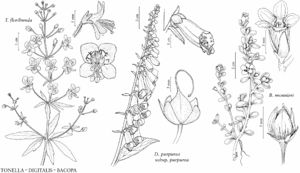Difference between revisions of "Bacopa monnieri"
Nat. Pflanzenfam. 67[IV,3b]: 77. 1891.
FNA>Volume Importer |
FNA>Volume Importer |
Revision as of 18:31, 24 September 2019
Perennials, sometimes annuals. Stems prostrate, 15–30 cm, glabrous. Leaves glabrous; blade fleshy, base narrowly cuneate, margins entire or serrate, apex obtuse, 1-nerved. Pedicels 5–30 mm; bracteoles present. Flowers: sepals 5, ovate to lanceolate, calyx radially symmetric; corolla white with yellow throat, 5–10 mm, lobes 5; stamens 4, didynamous. 2n = 64.
Phenology: Flowering Apr–Sep.
Habitat: Wetlands, wet sands, mud flats, riparian areas.
Elevation: 0–1500 m.
Distribution
Ala., Ariz., Calif., Fla., Ga., La., Md., Miss., N.C., Okla., S.C., Tex., Va., Mexico, West Indies, Central America, South America, s Europe, Asia, Africa, Australia, introduced in sw Europe (Portugal, Spain), Asia (China, Taiwan).
Discussion
Bacopa monnieri is thought to be native throughout much of its range, though it is weedy and cultivated. It readily colonizes irrigated fields, especially rice fields, and seeds easily get mixed with rice and are planted in new locations. Bacopa monnieri is introduced in parts of Europe (Portugal, Spain) and Asia (China, Taiwan). It can be propagated vegetatively by cuttings.
Bacopa monnieri is used medicinally in Asia in traditional Indian medicine (Ayurveda). It is edible and contains steroidal saponins, including bacosides, that have beneficial effects on the nervous system. Leaf, stem, and root extracts are used as cardiac and nerve tonics, sedatives, and vasoconstrictors. Leaves and stems are diuretic and used in treating constipation and indigestion. An alcohol extract of the whole plant has been used to treat Walker carcinoma and as a cardiovascular and muscle relaxer. In the United States, recent studies suggest it has potential for enhancing cognitive performance in the elderly and in the treatment of Alzheimer’s disease (C. Calabres et al. 2008; S. Aguiar and T. Borowski 2013). Extracts are used in the treatment of nerve and brain disorders; they also are believed to enhance intellect and decrease fertility.
Selected References
None.
